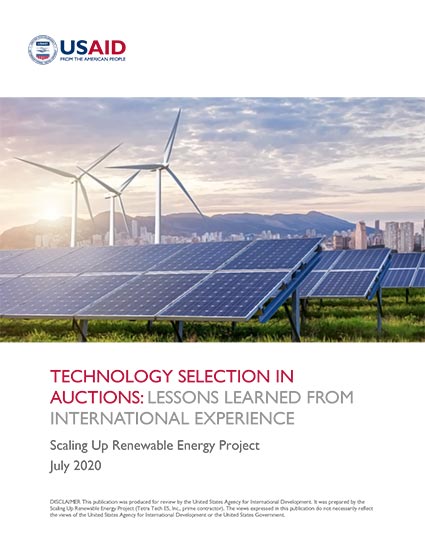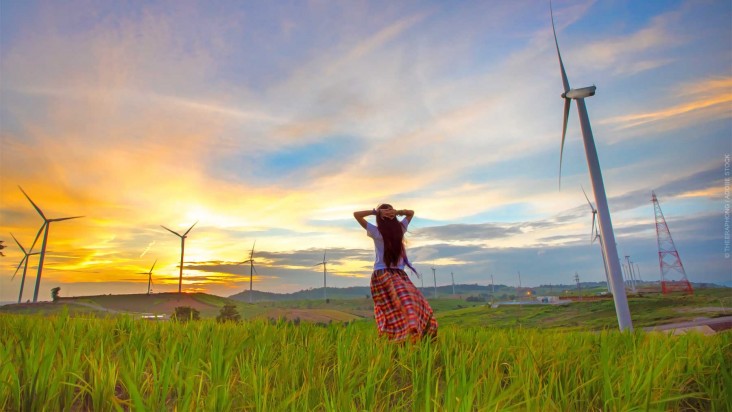- Energy Home
- How We Work
- Programs & Initiatives
- EmPOWERing Women and Girls
- Competitive Energy Procurement
- Auctions Toolkit
- Introduction
- Design
- Renewable Energy Integration
- Training
- Country Experience
- Resources
- Why Auctions?
- Designing RE Auctions
- Stages of Design
- Design Process
- Prequalification & Ceiling Prices
- Financial Guarantees & Penalties
- System-friendly Procurement
- Technology Selection
- Variable RE Forecasting
- Impact on System Operations
- System-friendly Procurement in Bangladesh
- Variable RE in Bangladesh
- Auctions Toolkit
- Toolkits
- Monitoring & Evaluation
- Resources
- Stories
Speeches Shim
Lessons Learned from International Experience
When choosing how to allocate auction demand and volumes, countries must decide which technologies should compete in the auction. Based on the policy objectives and the stage of the auction program, countries can choose to implement auctions from a broad technology spectrum.
As auction programs mature and the share of variable renewable energy in power systems increases, many countries find that grid integration concerns become a real barrier to scaling up renewable energy. Policymakers’ objectives often evolve from achieving low power generation costs to enhancing dispatchability and improving the value of renewable energy.
Technology Selection in Auction Design
Auction design plays an important role in achieving a country’s specific objectives, including minimizing generation and system costs, reducing windfall profits, achieving renewable energy and greenhouse gas emission targets, promoting a domestic renewable energy (RE) market, and creating local energy-related jobs. As part of the design process, policymakers choose which technologies are eligible to compete; auctions can be technology neutral and allow any technologies to compete or technology differentiated and allow a specific group of technologies to compete (multi-technology auctions) or allow only one specific technology to compete (technology-specific auctions). Although technology-specific auctions, such as a solar auction, are by far the most popular in the world, technology differentiated and technology neutral auctions are gaining in popularity as renewables increase on the grid.
Technology-neutral auctions do not place restrictions on what type of technologies can compete. Both conventional and RE developers bid against each other to supply energy through long-term contracts at the lowest possible price. Countries tend to design technology-neutral auctions because they are mandated by regulators or in order to minimize generation costs. It is important to note that technologies with the lowest generation costs will not necessarily result in the lowest system costs since technologies incur different system integration and grid expansion costs. In RE technology-neutral auctions, all RE technologies can compete, while conventional thermal technologies are excluded. RE technology-neutral auctions can help countries procure RE at least cost while meeting national energy targets and growing the domestic RE market.
Technology-differentiated auctions restrict which technologies can compete. These types of auctions can gather information on a technology’s costs and performance which is valuable for developing countries that may not have power markets to send the appropriate price signals. Technology-differentiated auctions also provide an incentive to the market to develop the industry in all desirable technologies. Multi-technology auctions limit participation to a certain subset of renewable energy technologies, such as solar or wind. Technology-specific auctions limit participation to only one desired RE technology. This type of auction is useful when policymakers know the location of the project or type of energy they want to procure.
How to Design Technology-Neutral and Technology-Differentiated Auctions
Auction design elements may impact technologies differently due to the technologies’ project development cycles. For example, while the realization of onshore wind projects may take up to several years, solar PV projects can sometimes be realized within a few months. Policymakers face a trade-off between creating a level playing field for technologies that may require certain discriminatory design elements and disregarding differences between technologies, leading to implicit disadvantages for some technologies.
To create fair competition among technologies, policymakers may need to require certain discriminatory design elements, such as prequalification requirements, penalties, realization periods, and ceiling prices. On the other hand, policymakers may refrain from such measures if the aim is to select projects and technologies with the shortest delivery times despite the potential competitive disadvantages for some technologies. Long uniform grace periods in contracts increase the risk that investors in technologies with short realization periods will speculate on decreasing costs and delay projects.
How to Address Additional Objectives in Technology-Neutral and Multi-Technology Auctions
Most countries implement technology-specific auctions because they allow more control over the auction objectives. Technology-specific auctions essentially impose qualification requirements on bidders, which have a direct impact on meeting auction objectives. If technology-neutral or multi-technology auctions are implemented, there are design options that can increase a policymaker’s ability to tailor the auction to specific objectives. Qualification requirements and discriminatory instruments can guide the winner selection process and can result in reduced system costs, progress on energy targets, and lower windfall profits.
Setting qualification requirements that group projects together can promote preferred power characteristics, such as technologies with a certain maturity level or generation profile. Setting technology-specific minimum or maximum quotas, granting bonus payments for certain technologies, or imposing technology-specific price ceilings can promote preferred technologies that will result in the desired auction outcomes.
Case Studies: Chile and the United Kingdom
Chile has designed auctions since 2014 to reduce electricity tariffs, encourage market competition, reduce electricity outages, facilitate RE system integration, reduce greenhouse gas emissions, and meet long-term supply contracts in the context of growing demand. In the 2017 auction, Chile enabled both RE and conventional technologies to compete for the provision of electricity in hourly or seasonal supply blocks. Each of the blocks had a base and a variable component. Only RE projects won, with the majority of awarded bids going to wind and solar. While the participation of technologies was not restricted, hourly and seasonal supply blocks are designed in a way to favor certain RE technologies in the winner selection process. The average bid price was $0.0325/kilowatt-hour (kWh), and the lowest bid (for a solar plant) was $0.0215/kWh, which was also the lowest price ever recorded in the country. The low bid prices can be attributed to strong competition in the auction round, with the submitted bids reaching a volume nine times higher than the volume contracted in the auction.
The U.K. designed a multi-technology auction that introduced competition within technology groups in order to limit producer surplus and reduce costs for consumers. This design set qualification requirements as well as technology-specific price ceilings and minimum and maximum quotas. The first and second auctions with this design seemed to achieve competitive contract prices, although a capacity cap favored smaller, more expensive plants, driving up the market clearing price.



Comment
Make a general inquiry or suggest an improvement.